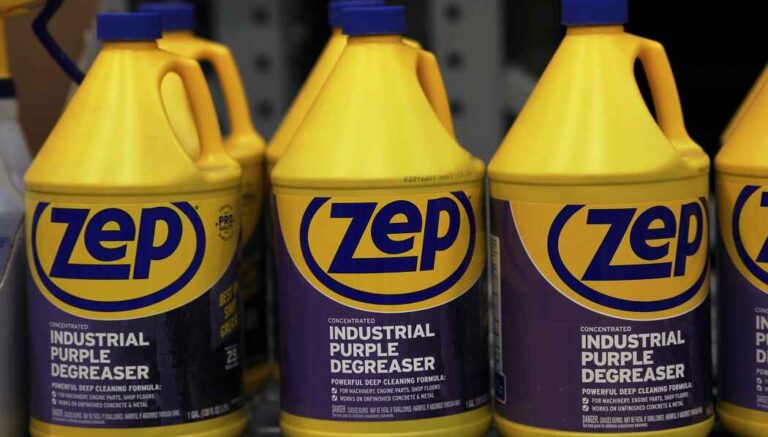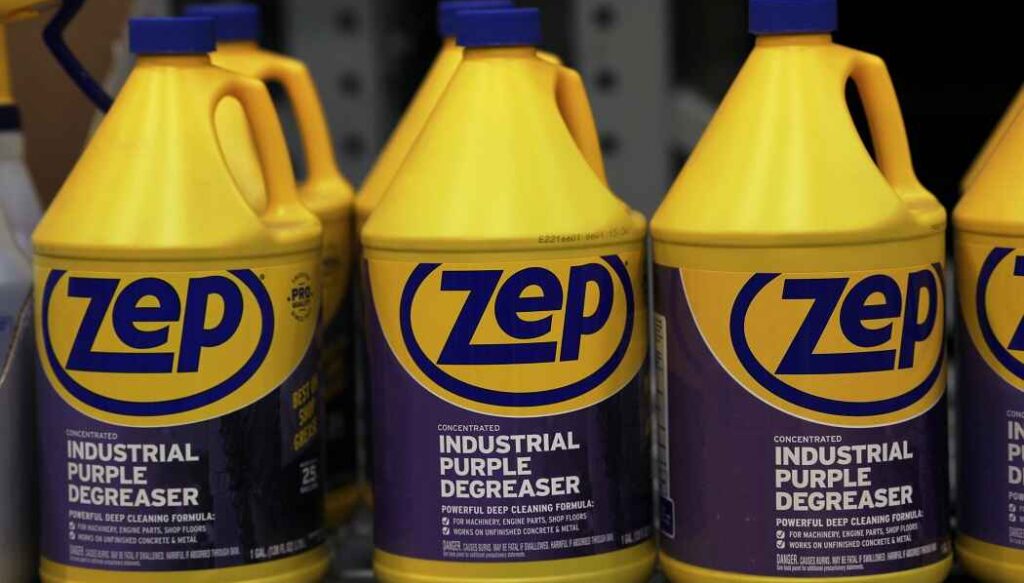
Can I Use Degreaser on Car Paint?
Maintaining the glossy exterior of your beloved vehicle is undoubtedly a top priority for any car owner. But, understanding the do’s and don’ts of car care is essential. One common question that arises when tackling tough grease and grime is,
“Can I use degreaser on car paint?” The answer to this query requires a careful consideration of various factors. While degreasers are commonly used in many industrial and household applications, their usage on car paint demands caution.

In this comprehensive guide, we will delve into the intricacies of degreasers and explore their compatibility with car paint. So, buckle up and get ready to explore the fascinating realm of degreasers and their role in car care.
What is Degreaser?
A degreaser is a cleaning agent specifically formulated to remove grease, oil, and stubborn stains from various surfaces. It is commonly used in industrial, commercial, and household settings. It is also effective for cleaning automotive parts and equipment, such as car engines, drivetrains, and tools.
Degreasers work by breaking down the molecular structure of grease and oil, allowing them to be easily wiped away or rinsed off. They are typically formulated with solvents, surfactants, and emulsifiers that facilitate the dissolution and suspension of greasy substances.
They come in different forms, such as sprays, liquids, gels, or powders, and can be water-based or solvent-based depending on the intended use and the type of grease or oil to be removed. They are valuable tools for effectively cleaning and degreasing machinery, engines, kitchen appliances, and various surfaces that encounter greasy build-up.
Can I Use Degreaser on Car Paint?
Using a degreaser on car paint can be done, it requires cautious attention to product selection, testing, and proper application techniques to avoid potential damage. However, there are a few drawbacks to consider.
Firstly, it is crucial to choose a degreaser that is specifically formulated for automotive use. Using household or industrial degreasers may contain harsh chemicals that can damage the car’s paint. It will lead to discoloration or fading. Look for a degreaser that is labeled as safe for automotive paint or recommended by the manufacturer.
Secondly, before applying the degreaser, it is advisable to test it on a small, inconspicuous area of the car’s paint. This will help determine any adverse reactions or potential damage. Apply a small amount of the degreaser, let it sit for a short time, and then rinse it off. If there are no negative effects, it should be safe to proceed with using the degreaser on the rest of the car.
Furthermore, when using a degreaser, follow the instructions provided by the manufacturer carefully. Some degreasers may require dilution with water, while others can be used directly. It is crucial not to leave the degreaser on the car’s paint for an extended period as it may cause damage. Always rinse the degreaser off thoroughly and dry the surface to prevent any residue from affecting the paint.
Lastly, keep in mind that using a degreaser on car paint should be reserved for specific situations where regular car washes or cleaning methods have not been effective in removing stubborn stains or grime. Overusing degreasers or applying them too frequently can strip away the car’s protective wax or clear coat, leaving the paint vulnerable to further damage and fading.
Can I Clean My Car with Degreaser?
Yes, you can clean your car with degreaser, but caution should be exercised. Degreasers are designed to remove oil, grease, and other stubborn stains from surfaces, making them useful for cleaning car engines, wheels, and heavily soiled areas. However, not all degreasers are suitable for cleaning the exterior or interior surfaces of your car.
When using a degreaser on your car’s paintwork or interior, it’s crucial to choose a degreaser specifically formulated for automotive use. Automotive degreasers are generally milder and safer for car surfaces. It minimizes the risk of damage or discoloration.
Dilute the degreaser according to the instructions and use a soft sponge or microfiber cloth to apply it to the targeted areas. Gently scrub the surface in a circular motion, paying attention to stubborn stains or grease buildup. Rinse thoroughly with clean water after cleaning to remove any residue.
Remember to avoid using degreasers on sensitive areas such as the car’s upholstery, leather seats, or electronic components, as these may require specialized cleaning products. In those cases, it’s best to consult the manufacturer’s recommendations or seek professional assistance.
What Happens If You Put Degreaser on Car Paint?
Applying degreaser directly to car paint can have detrimental effects and may cause damage to the paint finish. Here are some details on what can happen if you put degreaser on car paint:
Fading or discoloration: Many degreasers contain strong chemicals and solvents that can strip away the protective layers of clear coat on the car’s paint. This can lead to fading or discoloration of the paint, making it appear dull or patchy.
Paint damage: The harsh chemicals in degreasers can cause the paint to bubble, crack, or peel. This is particularly true if the paint is already compromised, such as having scratches or chips. The degreaser can seep into these areas and exacerbate the damage, resulting in the need for repainting or touch-up work.
Stain formation: Certain degreasers can leave behind stubborn stains on the paint surface. These stains can be difficult to remove and may require professional intervention to restore the original appearance of the paint.
Loss of gloss and shine: Degreasers can strip away the protective wax or sealant layer on the paint, which is responsible for providing the glossy finish and shine. As a result, the paint can lose its luster and appear dull.
Corrosion of metal parts: If the degreaser comes into contact with metal components such as chrome trim or aluminum accents, it can cause corrosion or etching on the metal surface. This can be particularly problematic if the degreaser is not rinsed off thoroughly.
Difference Between Safe and Harmful Degreasers for Car Paint
When it comes to maintaining the shine and integrity of your car’s paint, choosing the right degreaser is crucial. Understanding these differences can help you make an informed decision and protect your car’s prized finish. Let’s explore the contrasting features of safe and harmful degreasers for car paint.
Safe Degreasers for Car Paint:
Water-based degreasers: These degreasers are considered safe for car paint as they are non-toxic and environmentally friendly. They are typically made from natural ingredients and do not contain harsh chemicals that can damage the paint. Water-based degreasers are effective at removing dirt, grease, and oil without harming the paint surface.
pH-neutral degreasers: pH-neutral degreasers have a balanced pH level, usually around 7, which is neither acidic nor alkaline. They are specifically formulated to be gentle on car paint while still being effective at removing tough stains and grime. pH-neutral degreasers help maintain the integrity of the paint and prevent any discoloration or fading.
Citrus-based degreasers: These degreasers are derived from citrus fruits and contain natural solvents like d-limonene. They are effective in breaking down grease and grime without causing harm to the car’s paint. Citrus-based degreasers are non-toxic, biodegradable, and do not leave behind any residue or streaks.
Non-abrasive degreasers: Safe degreasers for car paint should be non-abrasive, meaning they do not contain any harsh scrubbing particles or chemicals that can scratch or dull the paint surface. They should have a smooth texture and should be applied gently using a soft cloth or sponge.
Tested and Approved: Look for degreasers that have been tested and approved by reputable automotive organizations or manufacturers. This indicates that the product has undergone rigorous testing and is considered safe for use on car paint.
Harmful Degreasers for Car Paint:
Petroleum-based degreasers: Petroleum-based degreasers, such as kerosene or gasoline, can be extremely harmful to car paint. They contain harsh solvents that can strip away the protective clear coat, fade the color, and cause long-term damage to the paintwork. It is crucial to avoid using these types of degreasers on car paint.
Acidic degreasers: Degreasers with high acidity, such as some wheel cleaners or heavy-duty engine degreasers, can be detrimental to car paint. Acidic compounds can eat away at the clear coat, causing it to break down and exposing the paint to damage. These degreasers should be avoided for car paint applications.
Harsh chemicals: Any degreaser that contains harsh chemicals like bleach, ammonia, or chlorine can be harmful to car paint. These chemicals can cause paint discoloration, fading, and even corrosion if left on the surface for an extended period. It is essential to read the product labels and avoid any degreasers with such ingredients.
Abrasive degreasers: Degreasers with abrasive particles or components can scratch or mar the car’s paint surface. These products are not suitable for delicate finishes and can cause irreversible damage. Avoid degreasers that claim to offer scrubbing or heavy-duty cleaning capabilities, as they may contain abrasive properties.
Unknown or Unreliable Brands: Be cautious of degreasers from unknown or unreliable brands. Stick to products that have a proven track record or are recommended by reputable automotive experts to minimize the risk of damaging your car’s paint.
Will Degreaser Damage Clear Coat?
The majority of degreasers are generally safe for clear coat finishes. But certain types damage clear coat finishes, especially if they are harsh or contain strong chemicals.
Clear coat is a protective layer applied to automotive paint to enhance its gloss and protect the underlying color coat. While clear coat is designed to be durable, it is still susceptible to damage from certain substances.
Choose a degreaser specifically formulated for automotive use and that is safe for clear coat surfaces. Look for products labeled as “clear coat safe” or “paint-safe” to minimize the risk of damage.
Is Degreaser Safe for Car Paint?
Using a degreaser on car paint is safe or risky; it largely depends on the specific product and the condition of your car’s paint.
As we mentioned earlier, some degreasers are designed specifically for automotive use and are formulated to be safe for car paint. On the other hand, harsh or abrasive degreasers can damage the paint and remove the protective clear coat.
Final Words
While degreasers are widely employed in various industrial and household applications, their compatibility with car paint requires careful consideration.
It is always advisable to consult the vehicle’s manufacturer guidelines or seek professional advice to ensure the appropriate products and methods are employed.
